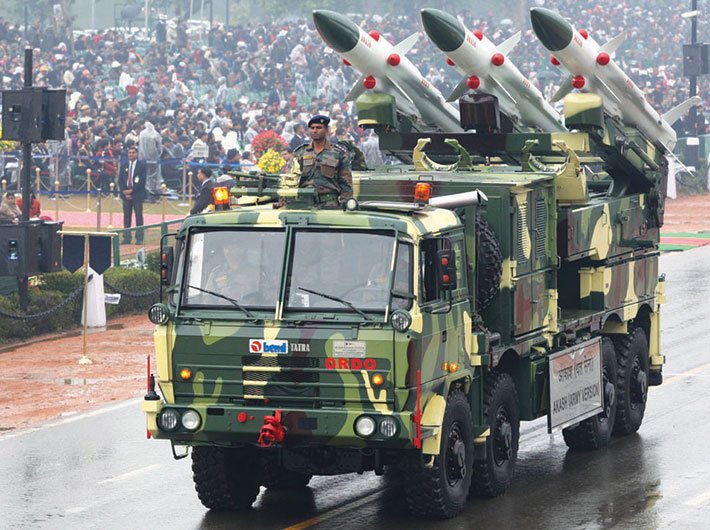Slowly yet steadily, New Delhi is strengthening its strategic influence in the Asia-Pacific region
India is increasingly turning to defence diplomacy to gain strategic depth in its neighbourhood and beyond, a move that is expected to checkmate China’s muscular domination.
Defence as a tool of diplomacy is helping India to win over friendly countries who are currently witnessing a lot of Chinese investment, particularly of the strategic kind that will help Beijing get a foothold right at India’s doorsteps. A wary India has moved swiftly to lean on defence diplomacy to dent Chinese designs.
During the April 8-10 visit of Bangladesh prime minister Sheikh Hasina to New Delhi, the two countries inked a defence cooperation frame-work (DCF) and a generous Line of Credit (LoC) worth $500 million was extended for the purchase of defence equipment from India.
“There are two reasons for doing so: first of all, we are trying to strengthen our strategic relationship with Bangladesh and also trying to create a market for our defence products that we have started producing now. Through such an exercise, we are also making efforts to counter China’s growing influence in the region,” Air Marshal (Retd) PK Barbora, who rose to become the vice chief of the air force in 2009, told Governance Now.
Until a few years ago, says Barbora who had also headed the Western Air Command – the most important operational area of IAF, New Delhi never used defence as part of its diplomatic initiative as “smartly and forcefully” as it is being seen currently. For this, he blamed the country’s previous leadership and raised an accusatory finger at the country’s ordnance factories and their management.
“They (ordnance factories) failed to meet our defence forces’ requirement, forget about fulfilling demands of our neighbours. You will be surprised to know that even Pakistan was able to sell its defence products to Sri Lanka and Bangladesh,” he says.
In fact, in November 2014, the then chairman of Pakistan Ordnance Factories (POF), Lt General Muhammad Ahsan Mehmood, preened before journalists in Wah cantonment in Pakistan’s Punjab province that “Islamabad is bringing in $20 million annually by selling weapons to over 40 countries.”
At the height of final war in Sri Lanka in 2009 between government forces and the Liberation Tigers of Tamil Eelam (LTTE), Pakistan, apart from supplying Colombo state-of-the-art rifles, mines, rockets and rocket launchers and other weapons, had reportedly taught the Sri Lankan Air Force air combat.
Ashok Sajjanhar, a former ambassador to Kazakhstan, Sweden and Latvia, says: “There is no harm in accepting the fact that we have lost the opportunity in the past, but we are gradually putting speed into our defence diplomacy vis-à-vis our rivals.”
The world watched keenly when India, during prime minister Narendra Modi’s visit to Vietnam in September 2016, signed a defence cooperation agreement with Hanoi and extended $500 million worth of LoC for the purchase of high-tech military equipment.
Official sources say that talks are on between New Delhi and Hanoi for the supply of Akash, a short-range surface-to-air missile, and other defence products to the Vietnamese forces. Sources, however, declined to comment on whether India would fulfill Vietnam’s demand for BrahMos super-sonic missile.
In order to strengthen its armed forces, Vietnam is said to have handed over India a wish list that includes Akash, BrahMos missiles and other top-of-the-line defence products.
This set off alarm bells in China. Venting its annoyance through state-owned media, Beijing asked India to desist from the sale of missiles and other weapons to Vietnam.
“If the Indian government genuinely treats its enhancement of military relations with Vietnam as a strategic arrangement or even revenge against Beijing, it will only create disturbances in the region and China will hardly sit with its arms crossed,” Global Times, China’s English tabloid newspaper, wrote in an op-ed on January 11.
But India was unfazed. Sources say Larsen & Toubro is constructing four offshore patrol vehicles under a $100 million LoC offered to Hanoi during president Pranab Mukherjee’s visit to the Southeast Asian nation in 2014.
New Delhi has not stopped at just providing defence hardware; it is imparting combat skills to Vietnamese soldiers and sailors. India is reportedly providing training to Vietnamese soldiers in the operation of Russia’s Kilo class diesel-electric submarine at INS Satvahana, the Indian navy’s submarine training school at Visakhapatnam.
A group of soldiers of the Vietnamese army have been trained at the Counter Insurgency and Jungle Warfare School in Mizoram.
Malaysia is also looking towards India to improve its defence preparedness. In the course of his March 30-April 4 visit to India, Malaysian prime minister Najib Razak was successful in winning India’s commitment to supply spare parts of Russia made Sukhoi SU-30 MKI to Kuala Lumpur.
Malaysia flies Sukhoi SU-30 MKM. Both Su-30 MKI, the variant used by India, and SU-30 MKM carry the identical technological components. Malaysia wants to source Sukhoi’s spare parts from India and in return sell all of its 10 MiG-29 fighter jets to New Delhi. India wants to upgrade these fighter jets for use by the IAF.
Malaysia is part of the 21-member Indian Ocean Rim Association (IORA) with which India has strong engagement on security, economic and diplomatic fronts. In particular, India is expediting its security-related projects across littoral states like Seychelles and Mauritius.
Mauritian prime minister Pravind Jugnauth’s May 26-28 visit to India further helped the two countries in developing a strong defence and security bond. Besides, handing over a $500 million worth of LoC, the two countries signed a maritime security pact. Under the India-Mauritius defence cooperation agreement, New Delhi has already provided patrol boats, helicopters and aircraft to Mauritius.
“Talks are on between the two countries (India and Mauritius) for enhanced security relations,” a source told Governance Now without parting with details.
After NDA came to power, India’s outreach in the Indian Ocean region has been effective and strong. New Delhi has set up surveillance radars in Mauritius, Seychelles, Sri Lanka and Maldives, and they have been linked to over four dozen sites in the country’s coastal areas. A delhi-based centre monitors activities in these places, revealed highly placed intelligence sources.
India is now looking beyond Asia. India, evidently unhappy with Australia’s growing proximity to China, disallowed Canberra from joining the multilateral India-America-Japan annual Malabar series of naval exercises. But it did go on to hold the second edition of the India-Australia bilateral maritime exercise AUSIINDEX-17.
All this will have an impact on the overall security dimension, under which Delhi’s defence outreach is being. executed. This is also being done partly to expand India’s defence market, which as per former defence minister Manohar Parrikar, will touch $2 billion by 2019.
Defence diplomacy coupled with strategic efforts will enable India to further strengthen its position with its allies like Bangladesh, Sri Lanka and Mauritius.
When prime minister Modi undertook his visit to Sri Lanka in May this year, his second since March 2015, he didn’t sign any new agreement with the island nation, but showed keen interest in ongoing India-funded projects which, according to the Indian high commission in Colombo, are in dozens.
The prime minister, as per sources, was also briefed about the port project in Trincomalee, in Sri Lanka’s eastern province. India is keen to develop the port for which, according to external affairs ministry spokesperson Gopal Baglay, “study” is being carried out. When completed, the port would help India’s gain strategic depth in the Indian Ocean Region which, as per the MEA, accounts for 90 percent of the country’s trade.
India is gaining strategic depth to neutralise overtures from China which is trying to increase its footprint in the third largest water body of the world. “Slowly, but steadily, India has started strengthening its defence and strategic build-up. It is developing ports in Bangladesh and Iran and has shown interest in building one in Sri Lanka. A charming fact is that all this is being carried out within the ambit of our aid diplomacy,” explained Sajjanhar.
India is also keen to build Bangladesh’s Payra port, which is a part of its strategic effort. The feasibility study to convert the harbour into a deep sea port has already been conducted. A senior official of the shipping ministry says, “India is waiting for a response from the Bangladesh government on the Payra project which is yet to be awarded.”
Describing the Payra port as a highly “sensitive port project”, the shipping ministry official told this correspondent that the talks are on between the authorities of the two countries and “hopefully things would be settled soon”.
shankar@governancenow.com
(The article appears in the July 1-15, 2017 issue of Governance Now)

